| | Captain America: the First Avenger (review) |
"I don't want to kill anyone. I just don't like bullies."
Two frustrated cartoonists in 1941 created a hero to deliver a punch to the jaw that Hitler would never forget. Joe Simon and Jack Kirby's creation went on to become an icon of comic book history and a rallying point for the soldiers serving in Europe. An awkward teenager desperate to enter the service, Steve Rogers was transformed through science into a paragon of physical perfection. With his unbreakable shield slung on his arm, he battled through World War II and beyond. Falling out of favor in the 1950's, he met cancellation only to return in a flash of color in the pages of the Avengers thanks to Stan Lee and Jack Kirby (now a member of the Marvel Comics bullpen).
In the comic book world, Captain America was a man out of time, a soldier from the past defending a world that he no longer understood. Fighting alongside colorful heroes, he was regarded as an ideal to strive toward. An elder statesman in tights, Captain America lacked the power of the Hulk, the technological abilities of Iron Man and the God-hood of Thor, but he made up for it in strength of character. How would a modern motion picture capture all of this while also appealing to an audience unfamiliar with his fame?
In the first Iron Man film, Nick Fury appears with an offer for Tony Stark to join the Avengers, in the Incredible Hulk, General Ross is visited by Tony Stark regarding his problem with the jade giant, Iron Man 2 is rife with appearances and references to the Marvel Comics stable of characters (often distracting from the main action). One of the most anticipated comic book movies of the Summer, Captain America: The First Avenger firmly embraces these steps toward establishing a unified Marvel Universe.
From the 1940's to the present day, this is the most definitive imagining of a world populated by superheroes to date. Whereas other efforts have resulted in cluttered results, Johnston's movie provides the solid base for a world that could produce Tony Stark's genius and the sheer destruction of the Hulk. By combining real world elements and fantastic imagery, the First Avenger is the Marvel Comics movie we've been waiting for.

Mark Johnston, familiar to many as the director of the Rocketeer, expertly depicted the world of 1942, complete with period accurate architecture, hair styles, fashions and mannerisms. Steve Rogers struggles to get through the application process into the Army. Seeking to shake his friend out of his mad mission to enlist, his best friend James Buchanan 'Bucky' Barnes insists on Rogers joining him on a double date to the World's Fair where everything from Howard Stark's flying cars to a real synthetic man (the original Human Torch) are on display. Despite the wondrous atmosphere, Rogers gravitates toward the Army enlistment base on site.
Barnes stands by him but can't understand why Rogers would be so ready to risk his life in war. For Rogers, it's simply the fact that he cannot stand bullies. He cannot draw a distinction between a lifetime of standing up to the regular beatings in numerous alleyways and the Allied Forces against the Axis Powers.
It's a quaint way to inform Roger's character regarding courage as a given. For the scrawny young man, there's no other way to live. If you start running from trouble, your troubles will never stop chasing you down. Johnston's film uses this trait as the centerpiece of his film as he builds up an opposing force far greater than anything we had seen before. Johann Schmidt, operating as the Red Skull, has a dream more horrifying than Hitler's. A superhuman being with abilities far beyond an ordinary human being, Schmidt is an incredibly brilliant scientist with a dark twisted mind to match his scarred face forever distorted in the form of a Red Skull.
Searching the ancient buildings of Sweden, the Red Skull and his team of Hydra goons unearth a vessel of vast power straight from the Asgardian armory of Odin. With the cube, Red Skull's organization known as Hydra is finally able to make a bid for global domination. With the brilliant engineer Arnim Zola at his side, the Skull builds a an engine of destruction capable of carving out a new empire.
- Captain America Hydra poster by Eric Tan
Unknown to the Red Skull and the Nazis, a young Steve Rogers has been chosen as part of a program designed to single out a soldier ideal for Dr. Erskine's Super Soldier formula. Led by Colonel Chester Phillips and Peggy Carter, the Strategic Scientific Reserve hopes that Erskine's formula will turn the tide of the war. A German refugee, Erskine bonds with Rogers, both are frustrated men who yearn to take part in the conflict against the Nazis but are betrayed by their frail bodies. Erskine tells Rogers of his encounter with Schmidt who stole an earlier version of his formula and became physically superior but deranged. Realizing that the serum enhances what is within a person, he realizes that it will make a good man like Rogers all that more remarkable.
Sadly, the Doctor is murdered after the procedure, leaving Rogers as the only one of his kind. This also leaves him as an oddity to the military who are unsure of his abilities in combat and refuse to risk losing the only specimen that they have. As a compromise, Rogers dons an absurd costume and takes to the stage drumming up support for the war. Reluctant at first, he eventually warms to the role of 'Captain America' and even enjoys the silly tights. It's only when he travels to the front lines and encounters the soldiers fighting at the front that he realizes how much of a fool he has been and how he has been cheated of his desire to fight alongside them.
Reunited with Peggy Carter and Colonel Chester Phillips, Rogers is horrified to learn that a platoon including his childhood friend Bucky has gone missing and there are no plans to mount what would be a doomed rescue attempt. His insistence to help out is laughed off by the Colonel who sees Rogers as a glorified cheerleader. However, once he is in action, it is clear that Rogers is the hope that the Allied Forces had been waiting for. Singlehandedly, he rescues his comrades, destroys the base and strikes a blow to the Red Skull's plans. With a brief glance of the Skull's war room, Rogers can see that Hydra has goals above winning the war and even seeks to destroy Berlin.
Returning to the camp Rogers is no longer a joke, he is regarded as Captain America, the Sentinel of Liberty who bravely faces impossible odds. Arranging a crack team of Howling Commandos (mainly consisting of soldiers that he liberated from the prison), Rogers begins a systematic assault on Hydra's operations.
- Close-up shot of Captain America’s redesigned costume from The Avengers 2012
- Captain America rides his customized Harley
- The Howling Commando
- Neal McDonough as ‘Dum Dum’ Dugan
- Hugo Weaving as the Red Skull
- The Red Skull in his very expensive roadster
- Hugo Weaving as the Red Skull
- The Red Skull consults Arnim Zola
- Chris Evans as Captain America and Sebastian Stan as Bucky
- Toby Jones as Arnim Zola
- Captain America poster by Eric Tan
- Captain America Hydra poster by Eric Tan
Leading his Howling Commandos, Rogers faces off against the impossibly advanced weaponry of Hydra. Drawing power from the Asgardian cube, the Red Skull's forces are able to disintegrate their enemies with a single shot. Yet Rogers manages to lead a small squad of men against these odds armed with conventional weapons and nerves of steel. There are of course casualties in his attacks. During a raid of a high speed train carrying Arnim Zola, Bucky is lost, deeply wounding Rogers' resolve.
Undeterred, Captain America storms the very mountainside fortress of Hydra and comes face to face with his enemy, the Red Skull. In the comics, the Skull was a normal man wearing a mask, acting as a rallying leader to the troops on the field, but with ambitions beyond his station. Kept alive by science, the Skull returned in the modern age to continue his battle with Captain America. In the film, the decision to make the Red Skull the recipient of an earlier version of the Super Soldier serum is ingenious. It makes the two men polar opposites in many more ways than they are on the printed page. For the Red Skull, their superiority to all others should make them allies, but to Rogers, his superhuman abilities are more of a reason to help and defend others rather than rule them.
The Red Skull and Captain America just do not see eye to eye.
The final battle between the Red Skull and Cap is incredibly thrilling, ranging from the hidden fortress to a flying wing and even into a dog fight in the skies. This level of high adventure has not been seen before in film and matches the comic book sensibilities and style with the technological advancements of film making.
Captain America: The First Avenger is a very long film (clocking in at just over two hours) but it every moment is used economically. Characters are developed well, scenarios are well established and the action is pitch perfect. Johnston's movie learns from previous comic book films and builds on those lessons to create an exciting high adventure epic that is grand in scope.
The fourth Marvel Entertainment film, Captain America: The First Avenger was a roaring success at the box office. Fighting against the most financially successful movie to date, the final Harry Potter film, it garnered significant profits and scoffed at those who felt the comic book movie genre was finished.
Reuters: Superhero movie "Captain America: The First Avenger" triumphed at the U.S. and Canadian box offices with $65.8 million in weekend ticket sales as the magic faded from the final "Harry Potter" film's record-breaking debut.
The film's total ticket sales now stand at $274.2 million in domestic theaters and $560.4 million internationally, for a combined total of $834.6 million.
The conclusion of Captain America: The First Avenger saw the first images of the big screen Avengers team that will premier next Summer. Donning a redesigned uniform, Rogers will join forces with Iron Man, Thor, and the Hulk along with special agents of S.H.I.E.L.D. Nick Fury, Black Widow and Hawkeye. An attendant of the 2011 San Diego International Comic Con got some up close photos of the new costume.
The seeds for a sequel were sewn into the First Avenger very well. Comic book author Ed Brubaker met with director Joe Johnston to make sure that his favorite character maintained the high level of attention that he received on the pages of his epic 'The Winter Soldier' and beyond:
"That scene with Bucky and the rifle? That was all me," he said after the credits rolled. Earlier in the night, I had sat down with him for dinner and an in-depth chat about Steve Rogers, James "Bucky' Barnes, the Winter Soldier and other matters of the red, white and blue chronicles, both on the page and on the screen. A central theme: the salvation of Bucky, Marvel's most famous martyr, and the Winter Soldier who just might enjoy his own season in the sun in Hollywood.
"It's amazing to think what Bucky has become and what he was. For years the only thing that was important about Bucky was the fact that he was the thing that Captain America lost. And that remains important — in fact it's the reason the Winter Soldier story worked. Cap still lost. If I was going to take away the tragedy of Bucky being killed in action, I had to replace it with something worse. Cap couldn't save Bucky and because he couldn't, Bucky became his own worst nightmare. And then in trying to save Bucky again — by giving him his memories back — Cap tortures Bucky by making him realize everything he did as the Winter Soldier too. Bucky is such a great tragic character and that tragedy has different sides to it now.
"For me, when I watch the movie tonight I'll be judging the Bucky a lot more than the Cap."
Via LA Times

Close-up shot of Captain America's redesigned costume from The Avengers 2012 image from http://www.comicbookmovie.com/fansites/MarvelFreshman/news/?a=42807
While the Red Skull appears to have met his end by handling the Asgardian tesseract (AKA the cosmic cube), it is likely that we will see him again. His final moments featured a glimpse of the nine realms, and as another blogger pointed out, the cube is one of many secret paths between Midgard and Asgard.
Via ComicBookMovie:
The biggest egg in my eyes is a simple phrase Loki says to Heimdall, "There are secret paths between the worlds to which even you with all your gifts are blind." This phrase set up the route to which Loki arrives on Earth for The Avengers. Yet after seeing TFA we know that the Cosmic Cube is a path between worlds, whether or not Heimdall can see these paths does not matter. What does matter, is the fact that now we have a way for Thor to get back to Earth in The Avengers. When the Skull was sucked into the World Tree, the cosmic universe looked very similar to a scene in Thor, meaning he could have ended up close to Asgard. At the end of Thor we see that Shield has the Cube in custody with the idea that it has unlimited power and it is hinted that Shield may know that the Cube is a gateway to another dimension. Now with Cap unfrozen, he will be able to explain what happened to the Skull, which could lead to someone using it to get Thor back on Earth. Although, I would assume that Loki will have obtained the Cube somehow before Thor is brought back to Earth which would become the day unlike any other.
As a teenager, I was more interested in the anti-heroes of comic books such as Wolverine or tragic heroes such as Daredevil. Captain America was too 'apple pie' for my taste. However, it took Jim Krueger, author of Earth X to clue me into what makes the character so great. His singular fortitude and belief that all people should be free is so noble and indefatigable. There's nothing the man cannot do and he firmly believes in the best of people.
The supporting cast of Captain America; The First Avenger was just astounding with Tommy Lee Jones and Hugo Weaving adding the right amount of star power presence to remind you why they are so successful. Dominic Cooper as Howard Stark nearly stole the film, depicting an earlier version of the sly and brilliant Tony Stark played by Robert Downey Jr. The most successful actress to date in a comic book film, Hayley Atwell was remarkable as Peggy Carter and I have to believe that she will return as Sharon Carter, the granddaughter to Peggy.
Johnston's film captures several aspects of the character of Captain America that make him so appealing. At a time when politics are a dangerous subject, he managed to make a patriotic movie without making it jingoistic or patronizing. Chris Evans, an actor many worried was too cocky or young for the part of Captain America proved that he was born to play the role. I look forward to seeing him in the Avengers and subsequent Cap sequels.
To order prints of the retro posters, please visit Mondo.
 | WordPress.com | Thanks for flying with WordPress! |
Trouble clicking? Copy and paste this URL into your browser: http://subscribe.wordpress.com


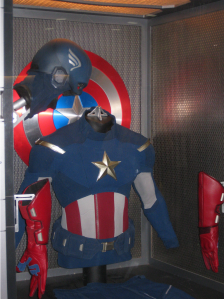

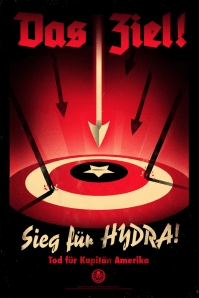

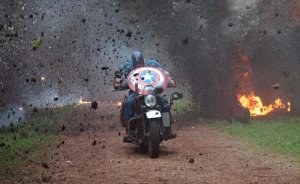
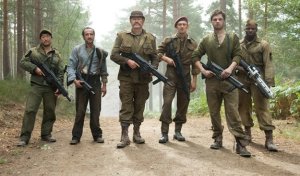
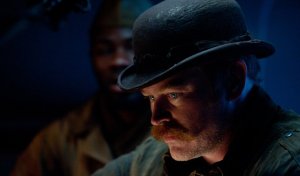
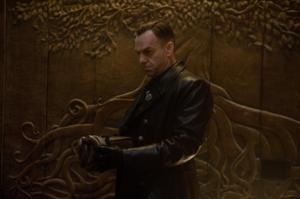
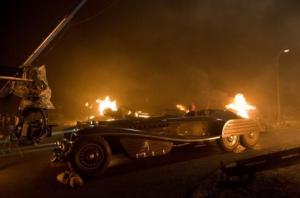
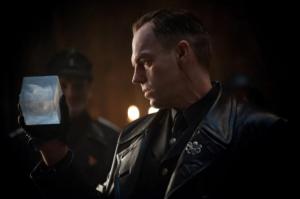


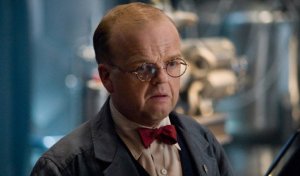
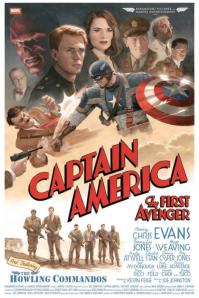
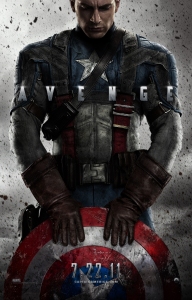

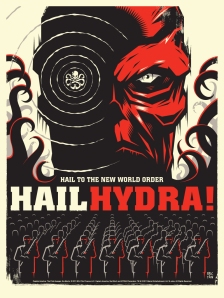

No comments:
Post a Comment